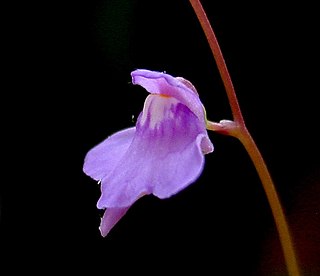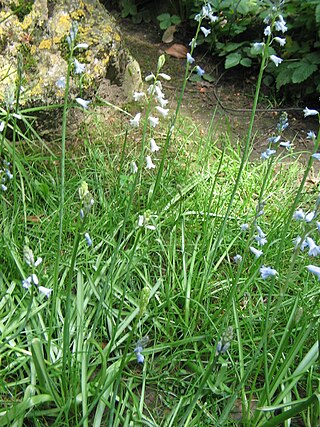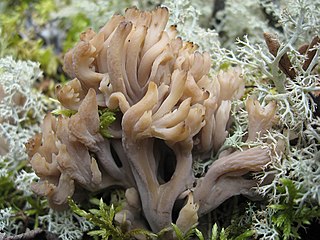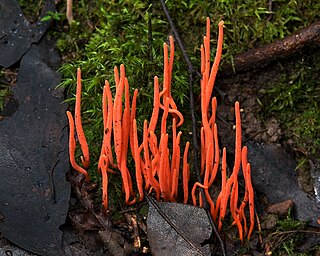
The Clavulinaceae are a family of fungi in the order Cantharellales. The family is not well defined, but currently comprises species of clavarioid fungi as well as some corticioid fungi. These species are nutritionally diverse, some being ectomycorrhizal, others wood-rotting saprotrophs, others lichenized, and yet others lichenicolous.

Utricularia amethystina, the Florida purple bladderwort, is a variable species of terrestrial bladderwort native to Bolivia, Brazil, Guyana, Peru, and south-west Florida. The small flowers can be purple, lilac, white, bluish, cream, or bright yellow, and are also highly variable in size and shape.

Lucien Quélet was a French naturalist and mycologist. Quélet discovered several species of fungi and was the founder of the Société mycologique de France, a society devoted to mycological studies.

The amethyst woodstar is a species of hummingbird in tribe Mellisugini of subfamily Trochilinae, the "bee hummingbirds". It is found in every mainland South American country except Chile and Uruguay and has been recorded as a vagrant on Trinidad.

The amethyst sunbird, also called the black sunbird, is a species of passerine bird in the family Nectariniidae. It is native to the Afrotropics, mostly south of the equator. They are commonly found in well-watered habitats, and undertake seasonal movements to visit flowering woodlands. The demise of some woodlands have impacted their numbers locally, but their range has also expanded along with the spread of wooded gardens.

Brimeura is a genus of bulb-forming, monocotyledonous perennial plants. They have narrow leaves and bear bluebell-like flowers in Spring. Brimeura is treated in the family Asparagaceae, subfamily Scilloideae, tribe Hyacintheae, subtribe Hyacinthinae. It contains the following species

Clavulina cristata, commonly known as the wrinkled coral fungus, white coral fungus or the crested coral fungus, is a white- or light-colored edible coral mushroom present in temperate areas of the Americas and Europe. It is the type species of the genus Clavulina.

Clavulina is a genus of fungus in the family Clavulinaceae, in the Cantharelloid clade. Species are characterized by having extensively branched fruit bodies, white spore prints, and bisterigmate basidia. Branches are cylindrical or flattened, blunt, and pointed or crested at the apex, hyphae with or without clamps, basidia cylindrical to narrowly clavate, mostly with two sterigmata which are large and strongly incurved and spores subspherical or broadly ellipsoid, smooth, and thin-walled, each with one large oil drop or guttule. The genus contains approximately forty-five species with a worldwide distribution, primarily in tropical regions. Species of Clavulina are mostly ectomycorrhizal. A recent study has identified Clavulina to the genera level as present on Nothofagus menziesii adventitious roots

Laccaria amethystina, commonly known as the amethyst deceiver, or amethyst laccaria, is a small brightly colored mushroom, that grows in deciduous and coniferous forests. The mushroom itself is edible, but can absorb arsenic from the soil. Because its bright amethyst coloration fades with age and weathering, it becomes difficult to identify, hence the common name "deceiver". This common name is shared with its close relation Laccaria laccata that also fades and weathers. It is found mainly in Northern temperate zones, though it is reported to occur in tropical Central and South America as well. Recently, some of the other species in the genus have been given the common name of "deceiver".

Clavulinopsis is a genus of coral fungi in the family Clavariaceae. The genus, first described scientifically by Casper van Overeem in 1923, has a widespread distribution.

The clavarioid fungi are a group of fungi in the Basidiomycota typically having erect, simple or branched basidiocarps that are formed on the ground, on decaying vegetation, or on dead wood. They are colloquially called club fungi and coral fungi.

Clavaria zollingeri, commonly known as the violet coral or the magenta coral, is a widely distributed species of fungus. It produces striking tubular, purple to pinkish-violet fruit bodies that grow up to 10 cm (3.9 in) tall and 7 cm (2.8 in) wide. The extreme tips of the fragile, slender branches are usually rounded and brownish. A typical member of the clavarioid or club fungi, Clavaria zollingeri is saprobic, and so derives nutrients by breaking down organic matter. The fruit bodies are typically found growing on the ground in woodland litter, or in grasslands. Variations in branching and color can often be used to distinguish C. zollingeri from similarly colored coral fungi such as Alloclavaria purpurea and Clavulina amethystina, although microscopy is required to reliably identify the latter species.
Clavulina floridana is a species of fungus in the family Clavulinaceae. It was originally described by Rolf Singer as Clavaria floridana in 1945, then E.J.H. Corner transferred it to Clavulina in 1950.

Clavulina cinerea, commonly known as the gray coral or ashy coral mushroom, is a species of coral fungus in the family Clavulinaceae. This grayish white edible fungus stands 2–10 cm tall, and can be found on the ground from July–October in Northeastern North America.
Clavulina puiggarii is a species of coral fungus in the family Clavulinaceae. It is found in Australia and Brazil.

Clavulina rugosa, commonly known as the wrinkled coral fungus, is a species of coral fungus in the family Clavulinaceae. It is edible.
Clavulina is a genus of aggulinated benthic foraminiferans with an elongate test. The early stage is triserial and triangular in section, the later stage uniserial and rectilinear, with angular to rounded section. In some species agglutinated walls have considerable calcareous cement. Septa are secondarily doubled as a result of imperforate floors, which are added as new chambers are formed. Walls contain fine bifurcating canaliculi within, openings of which are sealed internally by an inner organic lining, and externally by the imperforate surface layer of the wall. The aperture is interiomarginal in the early triserial stage, terminal and rounded in the adult.
Xylocopa amethystina, or Xylocopa (Nodula) amethystina, is a species of carpenter bee. It is distributed in South Asian countries such as, India, Pakistan and Sri Lanka.

Xylocopa auripennis, or Xylocopa (Biluna) auripennis, is a species of carpenter bee. It is widely distributed in South Asian countries, and Southeast Asian countries.
Arenodosaria is an extinct genus of foraminiferans. The species are known from the Miocene of New Zealand.














